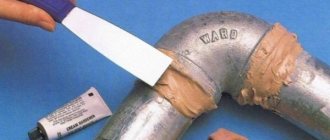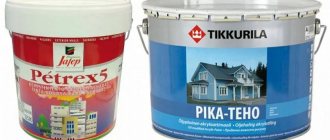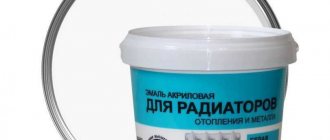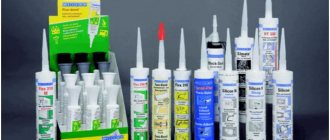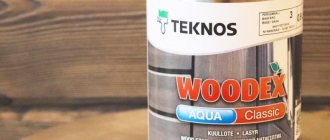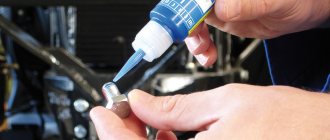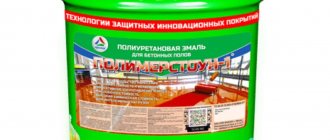The variety of paints and varnishes on the construction market is now so wide that sometimes even specialists are at a loss when faced with the choice of what to paint heating pipes with. Regularly repainting and tinting pipelines in an apartment is no longer interesting to anyone, so the requirements for the durability of the coating come first.
Properly selected paint will not only protect the metal from corrosion and emphasize the style of the room, but will also last a long time without cracking and maintaining its original color. By following the recommendations of professionals, you can quickly and efficiently paint pipes with your own hands.
Requirements for paintwork materials for heating systems
It would seem that choosing a product for painting pipes in a store is not difficult, you just need to make sure that the can is marked “For radiators” or similar, indicating the special purpose of the composition. However, there will probably be a lot of such cans, and they will differ not only in manufacturer and volume, but also in the type of paint. Therefore, you need to decide on the characteristics that it should have.
- Heat resistance.
All radiator paints have the ability to withstand high temperatures without damaging the coating. Elements of heating systems usually have a temperature of 50-90 degrees, so the heat resistance of the paint should be at least 80-90 degrees. More is better, some reserve never hurts.
Paint with heat resistance of 120 degrees Source kraski-pingam.ru
Advice! If repairs are planned during the heating season, you need to choose compounds that can be applied to a hot surface.
- Presence of odor.
When painting is carried out in non-residential premises, the presence of an unpleasant odor during work and before the coating dries does not matter. If people live in the house, it is better to choose odorless paint for heating pipes. A specific pungent aroma directly indicates the presence of harmful volatile substances in the composition that are hazardous to health. As a rule, they stop being released into the air after the paint has completely dried, but if the pipes are very hot, this process can be repeated. When using paint with a smell, it is necessary to ventilate the room or use respirators during work.
- Anti-corrosion properties.
They must have paints intended for metal pipes and radiators. However, if you need to change the color of modern aluminum or bimetallic devices with high-quality factory coating, this property can be neglected.
To protect against rust, you can apply a special enamel primer under the paint. Source wooood.ru
See also: Catalog of companies that specialize in finishing materials and related work
- Adhesive properties.
Pipes can be steel, copper, plastic, etc. The paint is selected so that it has high adhesion to the material.
- Durability.
Painting heating pipes is not the easiest or most enjoyable task; few people would like to do such work every year. Therefore, it is necessary to pay attention to the paint’s resistance to detergents, abrasion, and moisture resistance so that it can withstand wet cleaning and dry cleaning from household dirt.
- Decorative properties.
To ensure that pipes and radiators fit into the style and color scheme of the room, paint is selected according to color or the white base is tinted in the chosen tone. Matte or glossy also matters.
The choice of paints in color and texture is almost unlimited Source blogspot.com
On a note! Pipes painted in dark colors give off more heat than light ones.
Technology for painting polymer pipes
You can paint hot pipes made of polymer materials only after preliminary preparation. This is due to the fact that the glossy surface of the pipe prevents high-quality adhesion of the paint, and the coating will leave much to be desired, which will entail the need to apply several layers of paint. To prevent this, the surface of the pipe is cleaned with sandpaper.
Note! To process pipes, fine-grained sandpaper is used and the work is carried out without the use of power tools, since it is necessary to create only a slight roughness. Using a power tool can scrub the pipe too deep. During the heating season, polymer pipes can be painted only after sandpapering.
At the next stage, the pipes are wiped with a damp cloth after sanding to remove dust. Make sure the pipes are dry and clean before painting. After this, it is necessary to cover the floor and walls with protective material (film) to prevent paint from entering.
Types of heat-resistant paints
Paint for pipes and radiators is available on different bases. These are acrylic and silicone water-dispersion compositions, alkyd enamels, oil paints.
Acrylic
The most popular are acrylic paints. They dry quickly, have virtually no odor even at the time of application, do not emit harmful substances when heated, and at the same time have an affordable price. But when purchasing them, you need to pay attention to heat resistance - for such compositions it often does not exceed 80 degrees.
A fairly thick solution is easy to apply and does not spread, forming a smooth surface without smudges, but subject to preliminary priming of the base and a two-layer coating. The texture of such compositions is matte and glossy. The main disadvantage of acrylic paints is their low resistance to abrasion and mechanical damage.
Popular manufacturers
Here is a list of proven, popular and reliable paints for heating pipes:
- Dufa Heizkorperlack;
- Radiator Paint;
- Elementfarg Alkyd;
- Millertemp;
- Mipatherm 600;
- Radiator;
- UNIPOL enamel;
- GF-0119;
- VD-AK-1179.
Each of these paints and varnishes has its own composition, properties and technical characteristics. In addition, they have different prices. It is necessary to select a coloring solution based on financial capabilities, available shades of dye and personal preferences.
Video description
This video describes in detail the criteria for choosing paint and how to paint heating pipes:
Another type of paint can be considered the most advanced option in terms of quality, durability and durability of the coating. This is powder paint. But it cannot be applied under normal conditions; this requires special spraying equipment and a heat chamber for drying at a very high temperature.
In principle, batteries can be painted using this method if you temporarily dismantle them and negotiate with a car service center that performs body painting work. This cannot be done with pipes: the joints will remain visible after installation.
Conclusion
When choosing a dye for heating pipes, you need to make sure that the dye composition can withstand heating to high temperatures and will not harm human health. You should not purchase cheap, low-quality products that will not last long. It is better to buy paint and varnish material once from a reliable, trusted manufacturer, and follow all recommendations for surface preparation and painting. In this case, the painted pipes will be protected from damage and corrosion for a long time, and will remain attractive for many years.
How much paint do you need?
The paint consumption per layer is always indicated on the packaging. But this is an average value, which depends on the composition, the quality and type of surface, and the method of applying paint - manually or by spray.
Before you buy paint and paint a pipe, you will have to calculate the area of the surface to be painted by multiplying the circumference by the total footage of the pipe system. It is even more difficult to calculate the area of sectional batteries. If the product is new, this parameter can be found in its passport or search for information on the Internet.
Characteristics of a cast iron suspended radiator Source retrorossia.rf
Advice! If you have any difficulties with calculations, you can use an online calculator.
Temperature ranges
At what temperature is the use of special, heat-resistant primers required? Let's analyze the coating requirements at different operating temperatures.
Up to 60C
In particular, elements of autonomous heating systems fit into this temperature range. Their typical temperature difference between supply and return is 70/50C, which gives no more than +60C on the surface of the heating devices.
At temperatures from 0 to +60 you can safely use general purpose paints and primers. If the painting technology is followed (that is, if the surface is cleaned well and the primer matches the type of paint and varnish material), there is no need to worry about paint delamination or fading.
General purpose paints can be used in an autonomous heating circuit.
Up to 100C
The only significant difference from the previous scenario is the need to use paints with persistent pigments. The binder and primer remain the same as before: all popular types of paint can withstand prolonged heating without destruction.
Up to 300C
And here comes the high point of heat-resistant soils. If the instructions for using a temperature-resistant coating indicate the need for priming, you will have to select special compounds that can withstand prolonged heating and retain their properties over the entire range of operating temperatures.
Over 300C
All paints intended for temperatures above +300 degrees are applied without prior priming, directly onto a cleaned and degreased surface. A layer of soil at such temperatures will only increase the likelihood of the coating peeling off.
Particularly heat-resistant paints are applied directly to the metal base.
Briefly about the main thing
Openly laid heating pipes can disrupt the harmony of the interior of residential premises, especially if their color is far from the general color scheme. But they can be painted, and thus disguised or fit into the overall picture. And metal pipes also need painting to protect them from corrosion. Today, choosing paint for such pipes is not difficult; you just need to decide on requirements such as heat resistance, wear resistance, odor, and color.
Ratings 0
Coloring Tips
So that after painting the result is good, and the work does not need to be redone, again wasting time, money and effort, it is best to learn the painting technology and follow the advice of specialist painters. Professionals say that the quality of the final result largely depends on how correctly the preliminary preparation of metal heating pipes was carried out. By properly preparing the surface before painting, the paintwork will be beautiful, durable and wear-resistant.
Dye selection
Various types of coloring compounds can be used as a coating for polypropylene pipes, among which the following items stand out:
- standard paints used to protect metal surfaces;
- classic dyes intended for wall decoration;
- acrylic compositions, as well as mixtures designed specifically for plastic;
- polyurethane based dyes.
All of these types of coloring mixtures are commercially available and can be purchased at a hardware store.
When determining the coating application method for polypropylene, we proceed from the characteristics of the selected composition. Let's consider each of the options proposed above in more detail.
Advantages of half proplenovo pipe
Polypropylene has a number of advantages, including:
- heat resistance (due to which they are vikorist for drinking both cold and hot water);
- wear resistance;
- thickness and value;
- resistance to corrosion.
Plastic elements can be produced in different colors. For this reason, add barnberry to the plastic. What else is there to do if you bought plastic materials in a white color and couldn’t get hold of them?
The solution is to cover the plastic pipes with tarpaulin so that they fit into the interior of the room. For example, many people want to mix such elements under the color of the walls in order to make them less noticeable. And others, for example, should de-emphasize the prefabricated pipes. For example, you can prepare them in a green color and wrap them with pieced grape leaves. Prepared in such a manner, the stench will be as strong as that of a grape tree. This option is especially suitable for the kitchen.
What tools and materials will still be needed?
Heat-resistant silicone enamel in a can requires only a respirator and gloves. The application job is done quickly.
As for tools and materials for preparing the surface, a regular cord brush, a little acetic acid to remove rust and a couple of rags will do.
Preparing batteries for painting
I started by removing dust and dirt from the battery, then proceeded to remove the rust stain on the radiator. I rubbed the problem area several times with a vinegar rag and cleaned the surface with a cord brush.
Tip: Once the surface is prepared, do not forget to protect the wall behind the radiator. Attach cardboard or oilcloth to the wall with masking tape before you begin painting the radiator.
I used regular wrapping paper and glued it to the window sill. It wasn't wide enough for the radiator, but I just moved it as I moved towards the end of the battery.
Which pipes can be hot-painted and which cannot?
In theory, any pipes can be hot painted, be it metal or polypropylene.
The only thing is that the quality of the coating may require the best. Since paint enamels, when heated, will leave streaks. Therefore, all experts advise carrying out work only by turning off the heating system.
The fact is that the paint, no matter how good it is, is still designed for a cold surface and normal drying. If the process is combined with heating, the air in the room will be poisoned by toxic fumes.
But what to do if you still need to urgently paint the radiator? Use less dangerous compounds, thoroughly ventilate the room, and even better, go somewhere for 2-3 days until everything dries. For example, that’s what I did with my family.
Causes of condensation
Drops of water form and accumulate on the cold water supply pipeline due to high humidity and significant temperature changes. Before deciding how to remove condensation from a cold water pipe, you need to find out the reason for its formation.
The most common factors:
- improper organization of the ventilation system or poor exhaust, for example, due to blockage (especially in rooms with excessively high humidity);
- leaks of plumbing equipment due to improper installation or wear (leaking faucet, toilet tank);
- the difference in temperature in the area with cold water and in the room where it passes is a problem that arises in the summer, when the discrepancy is greatest;
- constant movement of cold water due to leaks higher up the riser (for example, neighbors’ cistern on the top floor is leaking);
- poor quality of thermal insulation of the cold pipeline, incorrect installation when distributing hot and cold water - the pipes are located very close to each other;
- high humidity in the room, which can be caused by: household reasons: laundry hung out to dry; steam from a boiling kettle or cooking food;
- atmospheric or geographical nuances (proximity of large bodies of water; frequent and heavy rainfall; humid climate);
- structural defects of the building that arose as a result of deviations from the technology at the construction stage (inadequate hydro- and thermal insulation of the foundation, floors).
Each of these factors can cause condensation to form on a cold water pipe. More often than not, several conditions are to blame. Rare isolated cases of moisture are not terrible, but the constant appearance of moisture is fraught with problems.
How to paint a heating radiator quickly and at no extra cost
An unpainted metal surface is unaesthetic and susceptible to corrosion, so any heating radiator is covered with a decorative layer at the factory. During operation of the device, the outer coating loses its appearance. It also happens that you just need to change the color of the battery. Then the question arises of how to paint a heating radiator and whether it is possible to renew the coating with your own hands, because paint is applied in production using a special technology. Modern coloring compositions allow you to do this kind of work at home, you just need to know some rules.
Modern coloring compositions allow dyeing in a variety of colors
What color should I paint the radiator?
When choosing which paint is best to paint a heating radiator, it is important to understand that it does not have to be white. You can deviate from boring standards and turn it into a decorative item. Combinations of shades look beautiful, especially in children's rooms, where you can realize your wildest design ideas. If you paint cast iron batteries in golden, bronze and silver shades, they will look very original. Antique models or those with decorative soldering will especially benefit from this color.
Cast iron radiator with decorative soldering
Contrasting painting will enliven the kitchen radiator; you can also use a “gradient” - a gradual “flow” of one shade into another.
Where to start working on updating the radiator
First you need to find out what paint is suitable for such work. You need to understand that the decorative coating must meet several requirements. A radiator is a device that heats up, and the most important condition when choosing paint is its heat resistance - it should not lose its properties when heated to 80-90°C. In addition, the following properties will be required:
- High adhesion. The coating should adhere well to the metal and not peel off when the battery temperature changes.
- Ability to resist corrosion. The paint must contain anti-corrosion components, especially if it is planned to be applied to a steel radiator.
- Strength. The coating must be abrasion resistant, especially for those radiators that are located in accessible places.
- Color fastness. The composition should not lose its original shade when heated, otherwise it will have to be renewed after each heating season.
- Safety. The coloring substance must be safe for the inhabitants of the house and not contain harmful substances that evaporate under the influence of heat.
